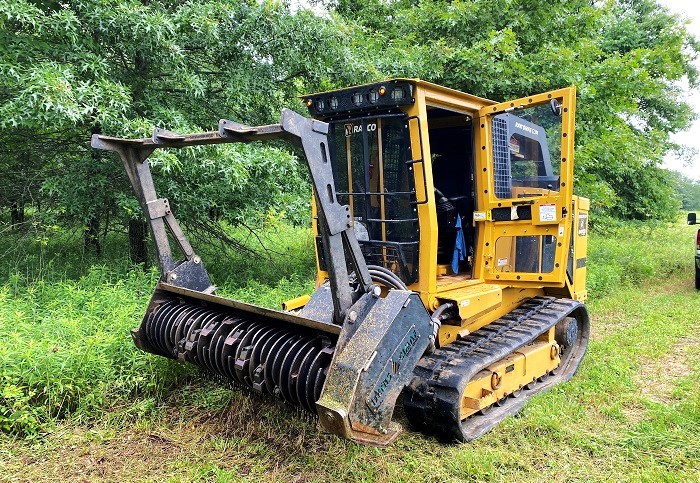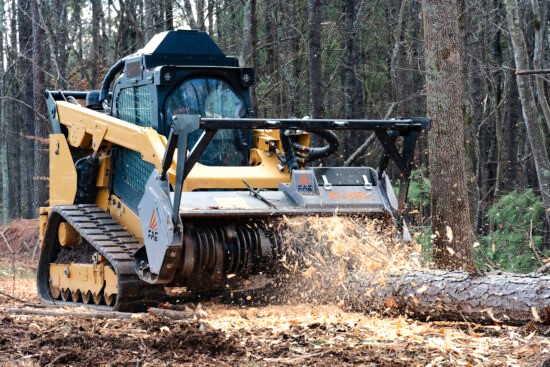
Forestry mulchers are powerful machines that can transform overgrown land into tidy and usable spaces. They are an invaluable tool for clearing brush, undergrowth, and even small trees. However, their power also means they need to be handled with extreme care to avoid accidents.
Understanding the Importance of Safety
Forestry mulchers are powerful, heavy-duty machines that demand respect. Their spinning teeth or drums can throw debris with significant force, potentially causing serious harm to operators or bystanders. Improper operation on uneven terrain could lead to machine rollovers. This article aims to provide essential knowledge for anyone considering using a forestry mulcher, whether for personal landscaping projects or professional endeavors.

Before You Start: Know Your Equipment and Your Terrain
- Study the Manual: Every forestry mulcher model is different. Before operating, meticulously read the manufacturer’s manual. Pay attention to safety instructions, maintenance, and ideal operating conditions.
- Assess the Terrain: Walk around the area you’ll be working on. Watch out for hidden obstacles like rocks, wires, or uneven ground that could increase the risk of an accident.
- Choose the Right Mulcher: There are various forestry mulcher types for different machines (skid steers, tractors, etc.). Make sure you have the right attachment for your carrier machine and the specific task at hand.
Safety Gear is Essential
- Eye Protection: Safety glasses or a full-face shield are mandatory to protect against flying debris.
- Hearing Protection: Mulchers are loud! Earplugs or protective earmuffs will prevent hearing damage.
- Hard Hat: Protects your head from falling branches or other potential hazards
- Sturdy Clothing: Long sleeves, pants, and work boots provide protection from debris and cuts.
- Safety Vest: If you’re working near traffic or other people, a high-visibility safety vest makes you more visible.
Safe Operational Practices
- Clear the Area: Ensure bystanders and pets are at a safe distance (at least 300 feet) before starting the mulcher.
- Maintain Visibility: Remove any brush or branches that obstruct your view of the work area. Good visibility is crucial.
- Slow and Steady: Never rush. Operate at a safe, controlled speed, especially on inclines or uneven ground.
- Slope Sense: When working on slopes, travel up and down, not across, to reduce rollover risk.
- Keep it Low: Avoid raising the mulcher attachment more than necessary. This decreases the likelihood of debris being thrown towards you or your machine.
- Beware of Kickback: If the mulcher bites into something too large, it can kick back. If that happens, disengage the mulcher immediately.
- Regular Breaks: Operating a forestry mulcher is demanding. Take regular breaks to stay alert and prevent fatigue.
Also Read: An In-Depth Look at Morning Glory Seedlings
Safe Machine Practices
- Regular Inspections: Check for loose bolts, damaged guards, or worn teeth/blades. Address any issues before starting work.
- Don’t Override Safeties: Never disable or modify the machine’s safety features.
- Exiting: Before dismounting, always lower the attachment to the ground, shut off the machine, and remove the key.
Additional Considerations
- Weather: Avoid working in strong winds or heavy rain, which can reduce visibility and increase risks.
- Fire Safety: In dry conditions, have a fire extinguisher available. Sparks from the mulcher could start a brushfire.
- Training: If you’re a novice, consider taking a training course or working alongside an experienced operator before going solo.
Remember: Safety First
Forestry mulchers are powerful and effective tools when used appropriately. By prioritizing safety, understanding your equipment, and following operating guidelines, you can significantly reduce the risk of accidents and achieve the land-clearing results you want.
